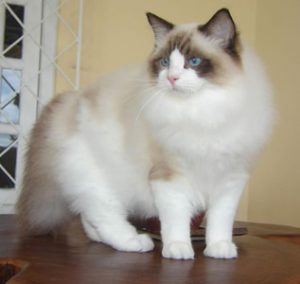
The Ragdoll is a cat breed with blue eyes and a distinct Colourpoint coat. It is a large and muscular semi-longhair cat with a soft and silky coat. Developed by controversial American breeder Ann Baker, it is best known for its docile and placid temperament and affectionate nature. The name “Ragdoll” is derived from the tendency of individuals from the original breeding stock to go limp and relaxed when picked up.
Temperament
The docile and floppy nature of the Ragdoll is a characteristic thought to be passed down from the Persian and Birman breed. There are contrary statements on whether this trait might be the result of genetic mutation.The extreme docility of some individuals have led to the myth that Ragdolls are pain-resistant. Some breeders in Britain have tried to breed away from the limpness due to concerns that extreme docility “might not be in the best interests of the cat.” Breed standards describe the Ragdoll as affectionate, intelligent, relaxed in temperament, gentle and easy to handle.
Physical characteristics
The Ragdoll is one of the largest domesticated cat breeds with a sturdy body, large frame and proportionate legs. A fully grown female weighs from 8 pounds (3.6 kg) to 15 pounds (6.8 kg). Males are substantially larger, ranging from 12 pounds (5.4 kg) to 20 pounds (9.1 kg). The genes for point coloration is also responsible for the blue eyes of the Ragdoll. More intense shades of blue are favoured in the show ring. While the breed has a plush coat, they consist mainly of long guard hair and the lack of a dense undercoat results in, according to the Cat Fanciers’ Association, “reduced shedding and matting”. Mitted Ragdolls, which weren’t allowed titling until the ’08-’09 show season, will often be confused for Birmans. The easiest way to tell the difference is by size (the Ragdoll being obviously larger) and chin colour (Ragdolls have white chins, while Birmans have coloured chins), although breeders recognise the two by head shape and boning.
Ragdolls come in 6 different colours – seal, chocolate, flame, and the corresponding “dilutes” such as blue, lilac and cream. This also includes the tortoiseshell pattern in all colours and the three patterns. All Ragdoll kittens are born white. They have good colour at 8 – 10 weeks and full colour and coat at 3 – 4 years. There are three different patterns:
Pointed – One colour darkening at the extremities (nose, ears, tail and paws)
Mitted – Same as pointed, but with white paws and abdomen. With or without a blaze (a white line or spot on the face), but must have a “belly stripe” (white stripe that runs from the chin to the genitals) and a white chin.
Bicolour — White legs, white inverted ‘V’ on the face, white abdomen and sometimes white patches on the back (Excessive amounts of white, or “high white,” on a bicolour is known as the Van pattern, although this doesn’t occur nearly as often as the other patterns).
—————————————————————————————————————–
CARING FOR YOUR CAT NEWSLETTER – Delivered Directly To Your Inbox – Starting Immediately – SIGN UP FOR FREE TODAY
—————————————————————————————————————–
